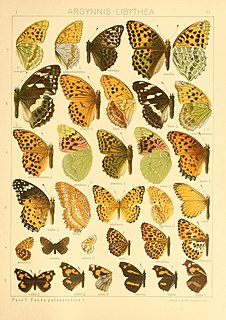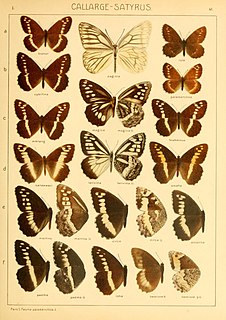
The genus Tacca, which includes the batflowers and arrowroot, consists of flowering plants in the order Dioscoreales, native to tropical regions of South America, Africa, Australia, Southeast Asia, and various oceanic islands. In older texts, the genus was treated in its own family Taccaceae, but the 2003 APG II system incorporates it into the family Dioscoreaceae. The APG III and APG IV systems continue to include Tacca in Dioscoreaceae.

Acropolis is a monotypic butterfly genus from the subfamily Satyrinae in the family Nymphalidae. The one species in the genus, Acropolis thalia, is distributed in western subtropical China. The genus was erected by Francis Hemming in 1934 based on a species described by John Henry Leech in 1891.

Scolitantides orion, the chequered blue, is a species of butterfly in the family Lycaenidae. It is found in Europe, Russia and east across the Palearctic to Japan.

Parnassius orleans is a high altitude butterfly which is found in Mongolia, western China and Tibet. It is a member of the snow Apollo genus (Parnassius) of the swallowtail family, Papilionidae. It was named after Prince Henri of Orléans who discovered it.

Parnassius szechenyii is a high-altitude butterfly which is found in western China. It is a member of the snow Apollo genus (Parnassius) of the swallowtail family, Papilionidae. The species was first described by Imre Frivaldszky in 1886.

Emmelia trabealis, the spotted sulphur, is a moth of the family Noctuidae. The species was first described by Giovanni Antonio Scopoli his 1763 Entomologia Carniolica.

Phragmatobia fuliginosa, the ruby tiger, is a moth of the family Erebidae.

Xestia baja, the dotted clay, is a species of moth of the family Noctuidae. It is found in Europe, Turkey, northern Iran, Transcaucasia, the Caucasus, central Asia, Siberia, Mongolia, Tibet, China, Korea and Japan.

Schinia scutosa, the spotted clover, is a moth of the family Noctuidae. It is found from Europe to southern Siberia, the Near East and the Middle East and from central Asia to Japan. In North Africa it is found from Morocco to Egypt.

The triple-spotted clay is a moth of the family Noctuidae found in most of Europe, northern Turkey, northern Iran, Transcaucasia, Caucasus, central Asia, from the Altai to Ussuri, Amur, Kuril Islands, northern Mongolia, Tibet, China, Korea, and Japan.

Diarsia brunnea, the purple clay, is a moth of the family Noctuidae. The species was first described by Michael Denis and Ignaz Schiffermüller in 1775. It is found in most of Europe, east to Transcaucasia, the Caucasus, central Asia, Siberia, the Kuriles, Amur, Ussuri, Sakhalin, Korea, Japan, Tibet and China.

Mimoides phaon, the red-sided swallowtail or variable swallowtail, is a species of butterfly in the family Papilionidae. It is native to the Americas.

Lopinga deidamia is a species of butterfly in the family Nymphalidae. It is found from the Urals to southern Siberia, China, Mongolia, Korea and Japan.

Argynnis zenobia is a butterfly found in the East Palearctic that belongs to the browns family.

Patricius lucifer is a butterfly found in the East Palearctic that belongs to the blues family.

Aulocera sybillina is a butterfly found in the Palearctic that belongs to the browns family (Nymphalidae). The species was first described by Charles Oberthür in 1890. It is endemic to China and Tibet.

Aulocera merlina is a butterfly found in the east Palearctic that belongs to the browns family (Nymphalidae). The species was first described by Charles Oberthür in 1890. It is endemic to Sichuan and Yunnan provinces in China. Subspecies A. m. pulcheristriataHuang, 2001 is described from Tibet.

Aulocera magica is a butterfly found in the East Palearctic that belongs to the browns family (Nymphalidae). It is endemic to western China and Tibet. The species was first described by Charles Oberthur in 1886.

Athyma punctata is a butterfly found in the Palearctic that belongs to the browns family. It is endemic to China


















